Pickguard Cutting
- Hippety Hop
- Blackwood
- Posts: 174
- Joined: Wed Apr 30, 2008 11:18 am
- Location: Moorabbin
Pickguard Cutting
So far I've only used a coping saw, and robo sander. Did a reasonable job. Just wondered if there's a better way?
Once tried the scroll saw to cut a printed circuit blank, but it just burnt/melted the plastic and wore the teeth off the blade.
Hip.
Once tried the scroll saw to cut a printed circuit blank, but it just burnt/melted the plastic and wore the teeth off the blade.
Hip.
[img]http://planetsmilies.net/not-tagged-smiley-10140.gif[/img][img]http://planetsmilies.net/person-smiley-1062.gif[/img]
Hippus Erectus
Hippus Erectus
-
Joe Sustaire
- Myrtle
- Posts: 92
- Joined: Sun Nov 23, 2008 1:23 am
- Location: Talihina Oklahoma
- Contact:
Hey Hip, if it's one of the peel and stick types, or around that thickness, I just use a large pair of sharp scissors. And I use sandpaper to smooth any bumps and then sandpaper to bevel the edges, which makes for a nice transition to the guitar top.
Joe
Joe
The only safe thing to do, is to take a chance! Mike Nichols
- Nick
- Blackwood
- Posts: 3628
- Joined: Thu Feb 26, 2009 11:20 am
- Location: Christchurch, New Zealand
- Contact:
Plastic/multilayered pickguards I've just cut on the bandsaw, use a course blade to avoid the clogging/heat issue. I usually put a piece of MDF down to act as a zero throat to avoid the course blade ripping the back of the plastic out. Once it's cut, a little file and sanding action to tidy the edge up then I either leave it like that if it's thinner stuff or I have a bevel bit for the router to give the multilayered stuff a touch of professionalism. 
"Jesus Loves You."
Nice to hear in church but not in a Mexican prison.
Nice to hear in church but not in a Mexican prison.
-
vandenboom
- Blackwood
- Posts: 414
- Joined: Sun Oct 26, 2008 2:27 pm
- Location: Melbourne (Ringwood), Australia
I have only made wood pickguards to date. I rough cut on band saw or coping saw and finish off with a drill press sander. But I notice your guard is plastic.This is probably a dumb question, but here goes anyway - can you route a plastic edge? If so, another option would be to make an mdf template, stick plastic to it with double sided tape, and go for it. I was thinking of trying that with the timber pickguards.
Frank
Frank
- Peter Young
- Myrtle
- Posts: 55
- Joined: Mon Jun 23, 2008 3:27 pm
- Location: Albany Western Australia
- Contact:
G'day all!
I've been following the forum for quite a while and also had the good fortune to meet Bob, Kim, Micheal, Allen and Tim at Playmakers back in February this year at Albany. Here goes for my first post ...
Never let it be said there is such a thing as 'waste' when it comes to lutherie. A variation on plastic pick guards is to manufacture them using thin off-cuts of wood, as these pics of WA Sheoak might help to illustrate.
I start by drawing the outline of the shape then, using a routing guide, I cut a thin channel a few millimetres in from the intended edge:
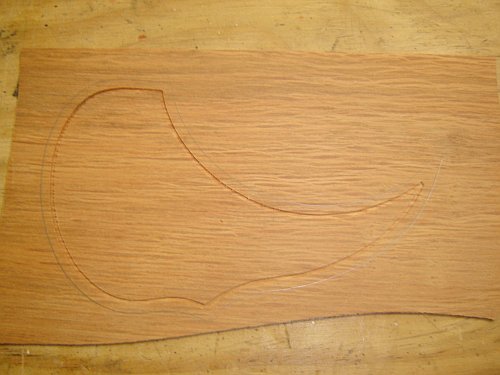
Once the channel is cut then the plate can be sawn & sanded to shape:
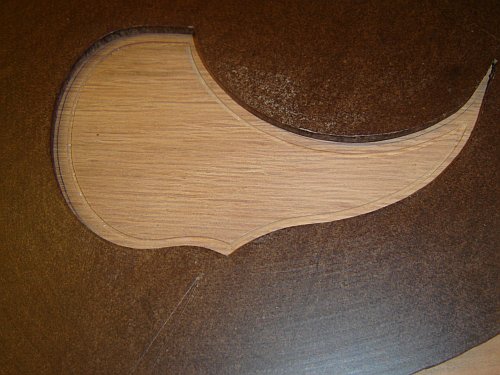
This channel is then filled with BWB binding:
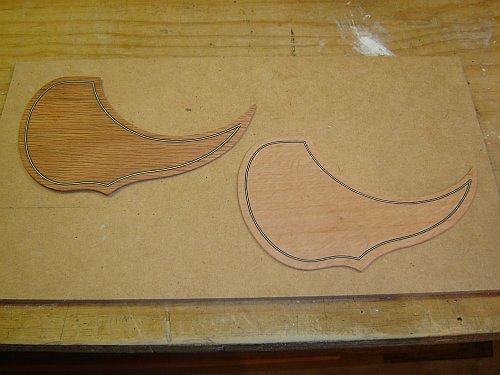
Then after final sanding and a couple of coats of Organoil, voila!:
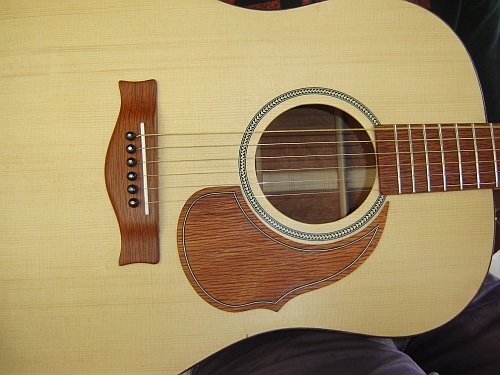
A pic of son Drew with his new pride and joy:
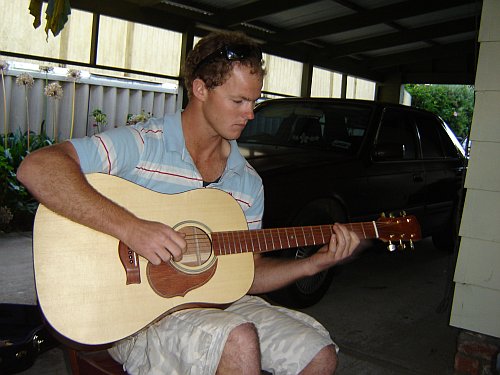
And here's a finished scratch plate made from Tassie Bluegum:
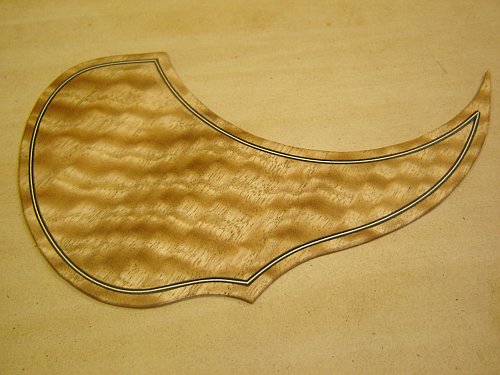
One advantage of using wood instead of plastic is that, if scratches build up over time, they can be sanded out and the plate then gets another light coat of oil.
Cheers for now & thanks,
Pete
I've been following the forum for quite a while and also had the good fortune to meet Bob, Kim, Micheal, Allen and Tim at Playmakers back in February this year at Albany. Here goes for my first post ...
Never let it be said there is such a thing as 'waste' when it comes to lutherie. A variation on plastic pick guards is to manufacture them using thin off-cuts of wood, as these pics of WA Sheoak might help to illustrate.
I start by drawing the outline of the shape then, using a routing guide, I cut a thin channel a few millimetres in from the intended edge:

Once the channel is cut then the plate can be sawn & sanded to shape:

This channel is then filled with BWB binding:

Then after final sanding and a couple of coats of Organoil, voila!:

A pic of son Drew with his new pride and joy:

And here's a finished scratch plate made from Tassie Bluegum:

One advantage of using wood instead of plastic is that, if scratches build up over time, they can be sanded out and the plate then gets another light coat of oil.
Cheers for now & thanks,
Pete
Last edited by Peter Young on Thu Jul 23, 2009 7:26 pm, edited 2 times in total.
In pursuit of the lies & lore of lutherie
- Hippety Hop
- Blackwood
- Posts: 174
- Joined: Wed Apr 30, 2008 11:18 am
- Location: Moorabbin
-
Joe Sustaire
- Myrtle
- Posts: 92
- Joined: Sun Nov 23, 2008 1:23 am
- Location: Talihina Oklahoma
- Contact:
-
vandenboom
- Blackwood
- Posts: 414
- Joined: Sun Oct 26, 2008 2:27 pm
- Location: Melbourne (Ringwood), Australia
- Bob Connor
- Admin
- Posts: 3115
- Joined: Mon Jul 09, 2007 9:43 pm
- Location: Geelong, Australia
- Contact:
Frank buddy the answer is yes. Stew-Mac sells a router bit just for this purpose although I suspect that other bits may work too.vandenboom wrote:I have only made wood pickguards to date. I rough cut on band saw or coping saw and finish off with a drill press sander. But I notice your guard is plastic.This is probably a dumb question, but here goes anyway - can you route a plastic edge? If so, another option would be to make an mdf template, stick plastic to it with double sided tape, and go for it. I was thinking of trying that with the timber pickguards.
Frank
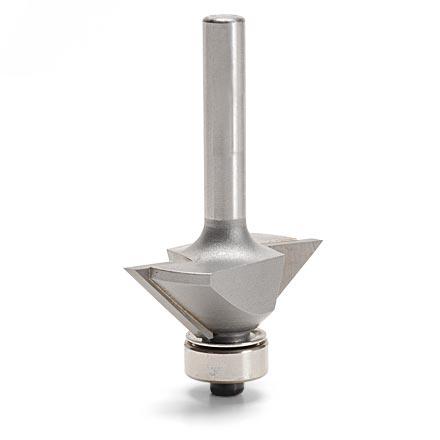
The bevel is important if you don't want the owners of your guitars to catch the polishing cloth on an edge every time they clean up the instrument.
Pete welcome to the forum!
- Peter Young
- Myrtle
- Posts: 55
- Joined: Mon Jun 23, 2008 3:27 pm
- Location: Albany Western Australia
- Contact:
- Peter Young
- Myrtle
- Posts: 55
- Joined: Mon Jun 23, 2008 3:27 pm
- Location: Albany Western Australia
- Contact:
I guess this is the debate. Some makers, I have heard, don't install a pick guard at all ....
I don't think the tone has been affected any more than if I used a regular (plastic) plate. The true test may be to string up and play the guitar in .... and then attach the plate. Not sure my abused ears would be good enough to judge ...... will try it with the next one.
Pete
I don't think the tone has been affected any more than if I used a regular (plastic) plate. The true test may be to string up and play the guitar in .... and then attach the plate. Not sure my abused ears would be good enough to judge ...... will try it with the next one.
Pete
In pursuit of the lies & lore of lutherie
Who is online
Users browsing this forum: Google and 51 guests